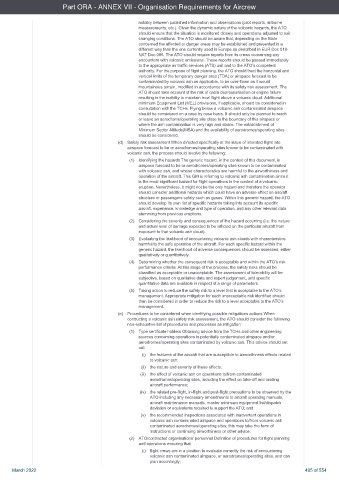Page 495 - UK AirCrew Regulations (Consolidated) March 2022
P. 495
Part ORA - ANNEX VII - Organisation Requirements for Aircrew
notably between published information and observations (pilot reports, airborne
measurements, etc.). Given the dynamic nature of the volcanic hazards, the ATO
should ensure that the situation is monitored closely and operations adjusted to suit
changing conditions. The ATO should be aware that, depending on the State
concerned the affected or danger areas may be established and presented in a
different way than the one currently used in Europe as described in EUR Doc 019-
NAT Doc 006. The ATO should require reports from its crews concerning any
encounters with volcanic emissions. These reports should be passed immediately
to the appropriate air traffic services (ATS) unit and to the ATO’s competent
authority. For the purpose of flight planning, the ATO should treat the horizontal and
vertical limits of the temporary danger area (TDA) or airspace forecast to be
contaminated by volcanic ash as applicable, to be over-flown as it would
mountainous terrain, modified in accordance with its safety risk assessment. The
ATO should take account of the risk of cabin depressurisation or engine failure
resulting in the inability to maintain level flight above a volcanic cloud. Additional
minimum Equipment List (MEL) provisions, if applicable, should be considered in
consultation with the TCHs. Flying below a volcanic ash contaminated airspace
should be considered on a case by case basis. It should only be planned to reach
or leave an aerodrome/operating site close to the boundary of this airspace or
where the ash contamination is very high and stable. The establishment of
Minimum Sector Altitude(MSA) and the availability of aerodromes/operating sites
should be considered.
(d) Safety risk assessment When directed specifically at the issue of intended flight into
airspace forecast to be or aerodromes/operating sites known to be contaminated with
volcanic ash, the process should involve the following:
(1) Identifying the hazards The generic hazard, in the context of this document, is
airspace forecast to be or aerodromes/operating sites known to be contaminated
with volcanic ash, and whose characteristics are harmful to the airworthiness and
operation of the aircraft. This GM is referring to volcanic ash contamination since it
is the most significant hazard for flight operations in the context of a volcanic
eruption. Nevertheless, it might not be the only hazard and therefore the operator
should consider additional hazards which could have an adverse effect on aircraft
structure or passengers safety such as gases. Within this generic hazard, the ATO
should develop its own list of specific hazards taking into account its specific
aircraft, experience, knowledge and type of operation, and any other relevant data
stemming from previous eruptions.
(2) Considering the severity and consequences of the hazard occurring (i.e. the nature
and actual level of damage expected to be inflicted on the particular aircraft from
exposure to that volcanic ash cloud).
(3) Evaluating the likelihood of encountering volcanic ash clouds with characteristics
harmful to the safe operation of the aircraft. For each specific hazard within the
generic hazard, the likelihood of adverse consequences should be assessed, either
qualitatively or quantitatively.
(4) Determining whether the consequent risk is acceptable and within the ATO’s risk
performance criteria. At this stage of the process, the safety risks should be
classified as acceptable or unacceptable. The assessment of tolerability will be
subjective, based on qualitative data and expert judgement, until specific
quantitative data are available in respect of a range of parameters.
(5) Taking action to reduce the safety risk to a level that is acceptable to the ATO’s
management. Appropriate mitigation for each unacceptable risk identified should
then be considered in order to reduce the risk to a level acceptable to the ATO’s
management.
(e) Procedures to be considered when identifying possible mitigations actions When
conducting a volcanic ash safety risk assessment, the ATO should consider the following
non-exhaustive list of procedures and processes as mitigation:
(1) Type certificate holders Obtaining advice from the TCHs and other engineering
sources concerning operations in potentially contaminated airspace and/or
aerodromes/operating sites contaminated by volcanic ash. This advice should set
out:
(i) the features of the aircraft that are susceptible to airworthiness effects related
to volcanic ash;
(ii) the nature and severity of these effects;
(iii) the effect of volcanic ash on operations to/from contaminated
aerodromes/operating sites, including the effect on take-off and landing
aircraft performance;
(iv) the related pre-flight, in-flight and post-flight precautions to be observed by the
ATO including any necessary amendments to aircraft operating manuals,
aircraft maintenance manuals, master minimum equipment list/dispatch
deviation or equivalents required to support the ATO; and
(v) the recommended inspections associated with inadvertent operations in
volcanic ash contaminated airspace and operations to/from volcanic ash
contaminated aerodromes/operating sites; this may take the form of
instructions or continuing airworthiness or other advice.
(2) ATO/contracted organisations’ personnel Definition of procedures for flight planning
and operations ensuring that:
(i) flight crews are in a position to evaluate correctly the risk of encountering
volcanic ash contaminated airspace, or aerodromes/operating sites, and can
plan accordingly;
March 2022 495 of 554

